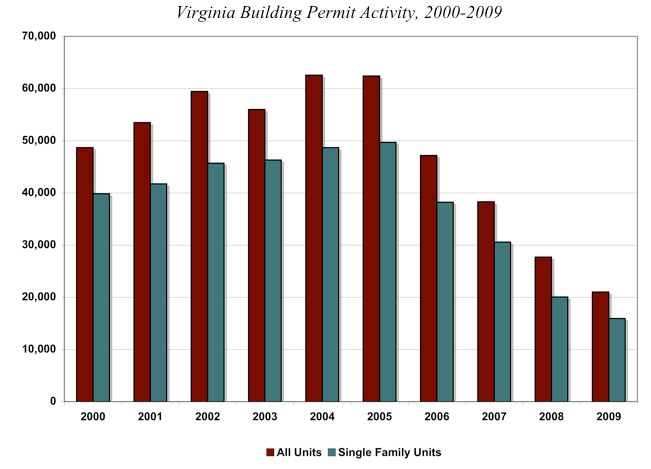Listen to the UVA Today Radio Show report on this story by Rebecca Arrington:
May 19, 2010 — New data on residential building permits issued in Virginia, compiled by the University of Virginia's Weldon Cooper Center for Public Service, paints a bleak picture of a housing industry hammered by the recession.
Despite federal tax credits to stimulate housing demand, the number of residential building permits issued last year continued a long-term slide that now has them off by more than 70 percent from the high-water mark set in 2004 and 2005.
"Consumer caution, recalcitrant lenders and the increasing number of foreclosed homes on the market have depressed demand for new homes. This is reflected in declines in residential building permits," U.Va demographer Mike Spar said. "As a result of a flooded market, home prices have continued to fall, which does not bode well for county and city revenue collections that depend heavily on property assessments."
From 2000 through 2005, the number of residential permits statewide grew from fewer than 50,000 per year to around 62,000 in both 2004 and 2005, the peak of Virginia's housing bubble.
Since then, new housing construction has fallen precipitously. In 2009, 21,000 permits were issued – a two-thirds reduction from 2005 and 70 percent less than 2004.
All planning districts in Virginia but one saw fewer building permits issued in 2009 than in 2004. Planning districts in northern Virginia were particularly hard-hit, with decreases ranging from 73 percent to 90 percent. Virginia's other major population concentrations (Richmond and Hampton Roads) were down 69 percent and 48 percent, respectively.
Only Crater Planning District in south central Virginia had a slight increase in construction activity between 2004 and 2009. The area comprises the cities of Colonial Heights, Emporia, Hopewell and Petersburg and the counties of Charles City, Chesterfield, Dinwiddie, Greensville, Prince George, Surry and Sussex. (Chesterfield has joint membership in both the Richmond Regional and Crater Planning Districts, Spar noted. He doesn't factor its data into the Crater Planning District. "Since the county began in the Richmond Regional, that's where I keep it.") Spar said the Crater Planning District gain is due to substantial growth in two localities, Petersburg and Hopewell.
Early indications based on comparing performance in the first quarter of 2010 to the first quarter of 2009 suggest slight improvement in building activity. Through the first quarter of this year, permits for 4,309 units were issued, compared to 3,951 in the same period in 2009. This 9.1 percent increase may indicate that 2010 will not be as bad as 2009, but is not sufficient to guarantee that the housing crisis has passed.
Spar said, "The best that can be said is that 2009 most likely represents the absolute bottom of the housing crisis in Virginia, but there is still a long way to go before the residential housing sector of the economy is back to normal."
May 19, 2010 — New data on residential building permits issued in Virginia, compiled by the University of Virginia's Weldon Cooper Center for Public Service, paints a bleak picture of a housing industry hammered by the recession.
Despite federal tax credits to stimulate housing demand, the number of residential building permits issued last year continued a long-term slide that now has them off by more than 70 percent from the high-water mark set in 2004 and 2005.
"Consumer caution, recalcitrant lenders and the increasing number of foreclosed homes on the market have depressed demand for new homes. This is reflected in declines in residential building permits," U.Va demographer Mike Spar said. "As a result of a flooded market, home prices have continued to fall, which does not bode well for county and city revenue collections that depend heavily on property assessments."
From 2000 through 2005, the number of residential permits statewide grew from fewer than 50,000 per year to around 62,000 in both 2004 and 2005, the peak of Virginia's housing bubble.
Since then, new housing construction has fallen precipitously. In 2009, 21,000 permits were issued – a two-thirds reduction from 2005 and 70 percent less than 2004.
All planning districts in Virginia but one saw fewer building permits issued in 2009 than in 2004. Planning districts in northern Virginia were particularly hard-hit, with decreases ranging from 73 percent to 90 percent. Virginia's other major population concentrations (Richmond and Hampton Roads) were down 69 percent and 48 percent, respectively.
Only Crater Planning District in south central Virginia had a slight increase in construction activity between 2004 and 2009. The area comprises the cities of Colonial Heights, Emporia, Hopewell and Petersburg and the counties of Charles City, Chesterfield, Dinwiddie, Greensville, Prince George, Surry and Sussex. (Chesterfield has joint membership in both the Richmond Regional and Crater Planning Districts, Spar noted. He doesn't factor its data into the Crater Planning District. "Since the county began in the Richmond Regional, that's where I keep it.") Spar said the Crater Planning District gain is due to substantial growth in two localities, Petersburg and Hopewell.
Early indications based on comparing performance in the first quarter of 2010 to the first quarter of 2009 suggest slight improvement in building activity. Through the first quarter of this year, permits for 4,309 units were issued, compared to 3,951 in the same period in 2009. This 9.1 percent increase may indicate that 2010 will not be as bad as 2009, but is not sufficient to guarantee that the housing crisis has passed.
Spar said, "The best that can be said is that 2009 most likely represents the absolute bottom of the housing crisis in Virginia, but there is still a long way to go before the residential housing sector of the economy is back to normal."
Media Contact
Article Information
May 19, 2010
/content/uva-researchers-report-bleak-2009-residential-building-activity-early-2010-figures-more

